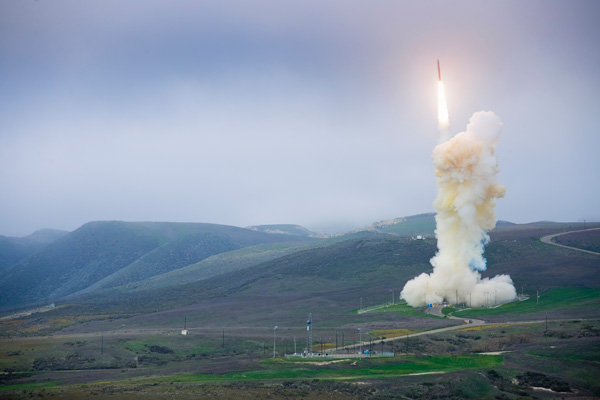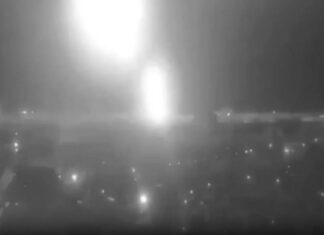By Riki Ellison
Sunday at high noon out of Vandenberg AFB, California provides a window of opportunity to test and demonstrate the reliability of the CE-II Ground Based Interceptor’s (GBI) capabilities to defend the United States of America from a single North Korean long-range ballistic missile.
The CE-II interceptor makes up a small portion of the overall fleet of 30 interceptors that are in place today in silos in Alaska and California. The majority of the fleet in the field are the CE-I first generation interceptors that began deploying in 2004. If successful, the CE-II is projected to replace the CE-I interceptors and to be on the additional 14 interceptors to be deployed that the President requested by 2017. The CE-II has not demonstrated a successful intercept, failing in its only two-intercept tests in 2010. Due to these failures to intercept, it has been recognized that the CE-II’s seeker, more sensitive than the CE-I, was more affected by the vibrations of its thrusters while in space, throwing off its inertial measuring of its exact location required to successfully collide with the incoming target ballistic missile.
The issue of dampening the vibrations in space within the CE-II Kill Vehicle has shown to be resolved in an extremely successful non-intercept test of the CE-II last year. In that test, the Kill Vehicle outperformed expectations that exceed well beyond a current and future projected long-range missile defense combat space environment. In addition to the dampening solutions, there has been four years of advanced technical development that has been put into this CE-II Kill Vehicle and on all of its boosters and rockets that propel to significantly increase its reliability.
The test on Sunday should be a technical breakthrough and leap ahead in its live demonstration to North Korea, Iran and the world, showing the United States successfully defeating a long range ballistic missile reentry vehicle surrounded by countermeasures and decoys. Anything less than success in this test will stop the CE-II interceptor development, deployment and production, leaving the United States completely reliant on the first generation CE-I kill vehicle to protect the United States.
Last Sunday in preview of this test, the Los Angeles Times published an article titled “40 Billion Missile Defense System Proves Unreliable” which misplaced the blame of responsibility for the reliability of the current system and misrepresented pertinent facts about the confidence our nation has today to track and destroy a long-range ballistic missile from North Korea with the current interceptors in Alaska and California. It is correct that our nation rushed deploy interceptors in 2004 because there was no defense for our nation against long-range missiles. That decision was driven by a report predicting a North Korean long-range capability within five years, and a 1998 North Korean missile test over Japan later that same year.
Four successful intercept tests in a row took place with these interceptors prior to the decision to deploy them in 2004, instilling confidence in the capabilities of the system to defend our nation. Since the initial deployment the CE-I, it saw three more successful intercepts which reinforced confidence in the technical capabilities of the system for a 75 percent confidence level in its last four tests. This same interceptor series provides the overwhelming majority of the current deployed interceptors protecting our nation today.
This system was never designed to be reliant on one shot; it operates by firing multiple interceptors at one missile thereby mathematically increasing confidence of reliability to intercept above 95 percent. None of the GBI interceptor tests have ever been operationally realistic because they just fire one interceptor at one missile. Our nation’s operational shot doctrine to fire multiple interceptors further increases confidence in the reliability to intercept above 95 percent.
In that regard, our tests, which fire one missile against one target missile are much more demanding than our operational employment. Moreover, we clearly know where the North Korean launches start from, what their exact speeds and trajectories are to strike the United States and what the most likely warhead configuration and countermeasures on their missiles will be. Of course we should be conducting scripted tests against those exact specifics within the limitations of our test ranges over and over again. This is what increases confidence in the system protecting the nation.
The responsibility of the failures and lack of annual testing of the CE-IIs is not due to the rush to deployment in 2004. It is directly related to the misguided leadership of the previous MDA director, and the lack of investment from the President’s budget into this system since 2008.
These leadership decisions and lack of adequate funding over this time period impacted the confidence, reliability, maintenance and modernization of the entire GBI fleet and the system as a whole. In 2009, the new Multiple Kill Vehicle (MKV) replacement that the nation was invested in for all of the interceptors was halted and cancelled in 2010, and a cheaper adaptation to the interceptor was selected. That aggravated, rather than solved the problem that this test on Sunday will hope to overcome.
Furthermore, a new long-term development support contract with Boeing was put in place that incentivized cost cutting rather than increased reliability and confidence in the system. Added to this was a reduction from the President’s budget from $1.4 billion to $761 million towards the development and research of these interceptors as well as having to add 14 new interceptors per the President’s request in March 2013. Then on April 30, 2014 a GAO report came forward on the cost to fix and demonstrate the CE-II rising from $236 million to $1.3 billion to get the system corrected that is yet to be budgeted. The dismal intercept record and lack of intercept testing of the CE-II interceptors for four years is a reflection of leadership and lack of investment.
The MDA Budget Request from FY 2010, the first budget request on under former MDA Director LTG Patrick O’Reilly, stated:
“We are requesting $983 million for the midcourse PE in FY 2010 compared to the $1.507 billion appropriated for this PE in FY 2009. Much of the decrease is attributable to transferring the European Capability funding (including testing of the two stage boost vehicle) to its own, new PE. Also we intend to stop construction of Missile Field #2 at Fort Greely, Alaska, curtail GMD development, and decrease the planned number of emplaced GBIs from 44 to 30. This reduction in silos still provides the United States with a substantial inventory of operational GBIs considering the very limited number of ICBM complexes in North Korea and Iran.”
It is noteworthy that the President ultimately saw the course of action described in the 2010 MDA budget as the wrong course, and cancelled the SM-3 IIB interceptor and Phase 4 of the EPAA for the European Capability funding, a sizable investment of millions of dollars and engineering time. The President also reversed MDA’s decision to curtail GMD and has increased the GBIs from 30 to 44 with construction on Missile Field #2 at Fort Greely in 2013, deciding that 30 GBIs was not enough inventory to handle the missile threat from North Korea and potentially Iran.
Our ground based missile defense system represents the very best of our technology, requires the very best engineering and is the only system our nation has to defeat long-range ballistic missiles. In its operational employment today it has the utmost confidence of our war fighters who are responsible for defending the United States of America. It is important that we continue to develop this technology and improve the systems that are fielded today. But it is very hard to do. It is, after all, rocket science – hitting metal on metal at Mach speeds within centimeters in space and it requires sustained investment and great leadership that changes culture to win like all world championship winning organizations and teams do.
High Noon on Sunday will define the future for GMD, its investment, and its leadership.
Riki Ellison is the Chairman & Founder of the US Missile Defense Advocacy Alliance.




















